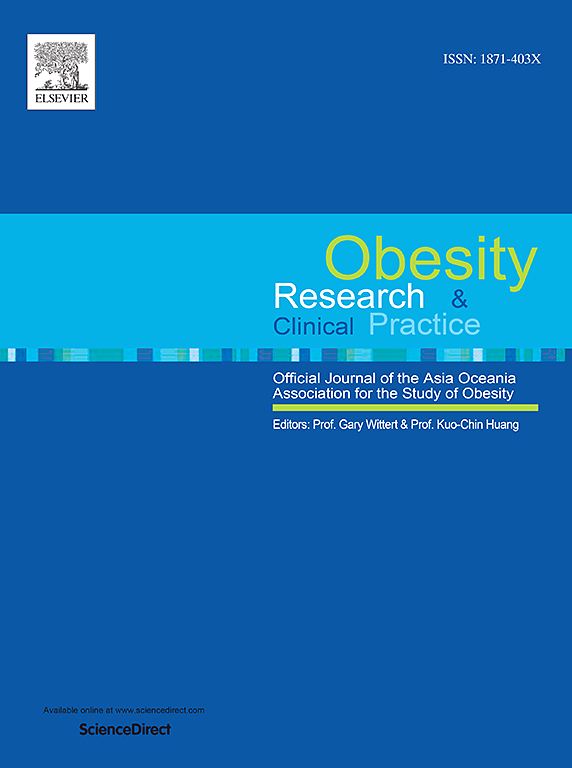3 G米对肥胖或2型糖尿病患者血浆葡萄糖、胰岛素和胃肠道激素的影响:一项非随机实验研究
IF 2.5
4区 医学
Q3 ENDOCRINOLOGY & METABOLISM
引用次数: 0
摘要
目的:评价新型谷物品种3 G米与传统白米相比对肥胖和2型糖尿病(T2D)患者餐后血糖、胰岛素血症和胃肠道激素的影响。方法:采用非随机实验研究方法,选取20例肥胖(无糖尿病)患者和20例t2dm患者。每个参与者食用含有50 克碳水化合物的膳食,这些碳水化合物来自3 克大米或白米。血浆葡萄糖、胰岛素和胃肠道激素水平在基线和间隔120 min后测量。结果:在肥胖参与者中,与白米饭相比,3 G后90和120时的血糖水平显著降低(0.52 ± 0.04 vs. 2.58 ± 0.37 mmol/L, p )。结论:3 G大米显著改善了肥胖个体餐后血糖控制,增强了胃肠道激素反应。这些发现强调了3 G大米作为控制餐后血糖和胰岛素敏感性的饮食干预的前景。本文章由计算机程序翻译,如有差异,请以英文原文为准。
Impact of 3 G rice on plasma glucose, insulin, and gastrointestinal hormones in patients with obesity or type 2 diabetes: A non-randomized experimental study
Objective
To evaluate the effects of a novel grain variety 3 G rice compared to traditional white rice on postprandial glycemia, insulinemia, and gastrointestinal hormones in individuals with obesity and type 2 diabetes (T2D).
Methods
A non-randomized experimental study was conducted with 20 participants with obesity (without diabetes) and 20 patients with T2D. Each participant consumed meals containing 50 g of carbohydrates from either 3 G rice or white rice. Plasma glucose, insulin, and gastrointestinal hormone levels were measured at baseline and intervals up to 120 min post-consumption.
Results
Among participants with obesity, plasma glucose levels were significantly lower at 90 and 120 after 3 G compared to white rice (0.52 ± 0.04 vs. 2.58 ± 0.37 mmol/L, p < 0.001 at 90 min and 0.06 ± 0.02 vs. 1.47 ± 0.26 mmol/L, p = 0.003 at 120 min). In contrast, plasma insulin levels were markedly higher following 3 G rice consumption at 90–120 min (p = 0.003). Gastrointestinal hormones were significantly elevated after 3 G rice intake compared to white rice, with GLP-1 levels showing sustained increases from 60 to 120 min (p = 0.019). In T2D patients, 3 G rice consumption led to a modest reduction in plasma glucose at 120 min (5.15 ± 0.49 mmol/L for white rice vs. 3.57 ± 0.35 mmol/L for 3 G rice, p = 0.0262) without significant effect on other parameters.
Conclusion
3 G rice significantly improved postprandial glycemic control and enhanced gastrointestinal hormone responses in individuals with obesity. These findings highlight the promise of 3 G rice as a dietary intervention for managing postprandial glycemia and insulin sensitivity.
求助全文
通过发布文献求助,成功后即可免费获取论文全文。
去求助
来源期刊

Obesity research & clinical practice
医学-内分泌学与代谢
CiteScore
7.10
自引率
0.00%
发文量
80
审稿时长
49 days
期刊介绍:
The aim of Obesity Research & Clinical Practice (ORCP) is to publish high quality clinical and basic research relating to the epidemiology, mechanism, complications and treatment of obesity and the complication of obesity. Studies relating to the Asia Oceania region are particularly welcome, given the increasing burden of obesity in Asia Pacific, compounded by specific regional population-based and genetic issues, and the devastating personal and economic consequences. The journal aims to expose health care practitioners, clinical researchers, basic scientists, epidemiologists, and public health officials in the region to all areas of obesity research and practice. In addition to original research the ORCP publishes reviews, patient reports, short communications, and letters to the editor (including comments on published papers). The proceedings and abstracts of the Annual Meeting of the Asia Oceania Association for the Study of Obesity is published as a supplement each year.
 求助内容:
求助内容: 应助结果提醒方式:
应助结果提醒方式:


